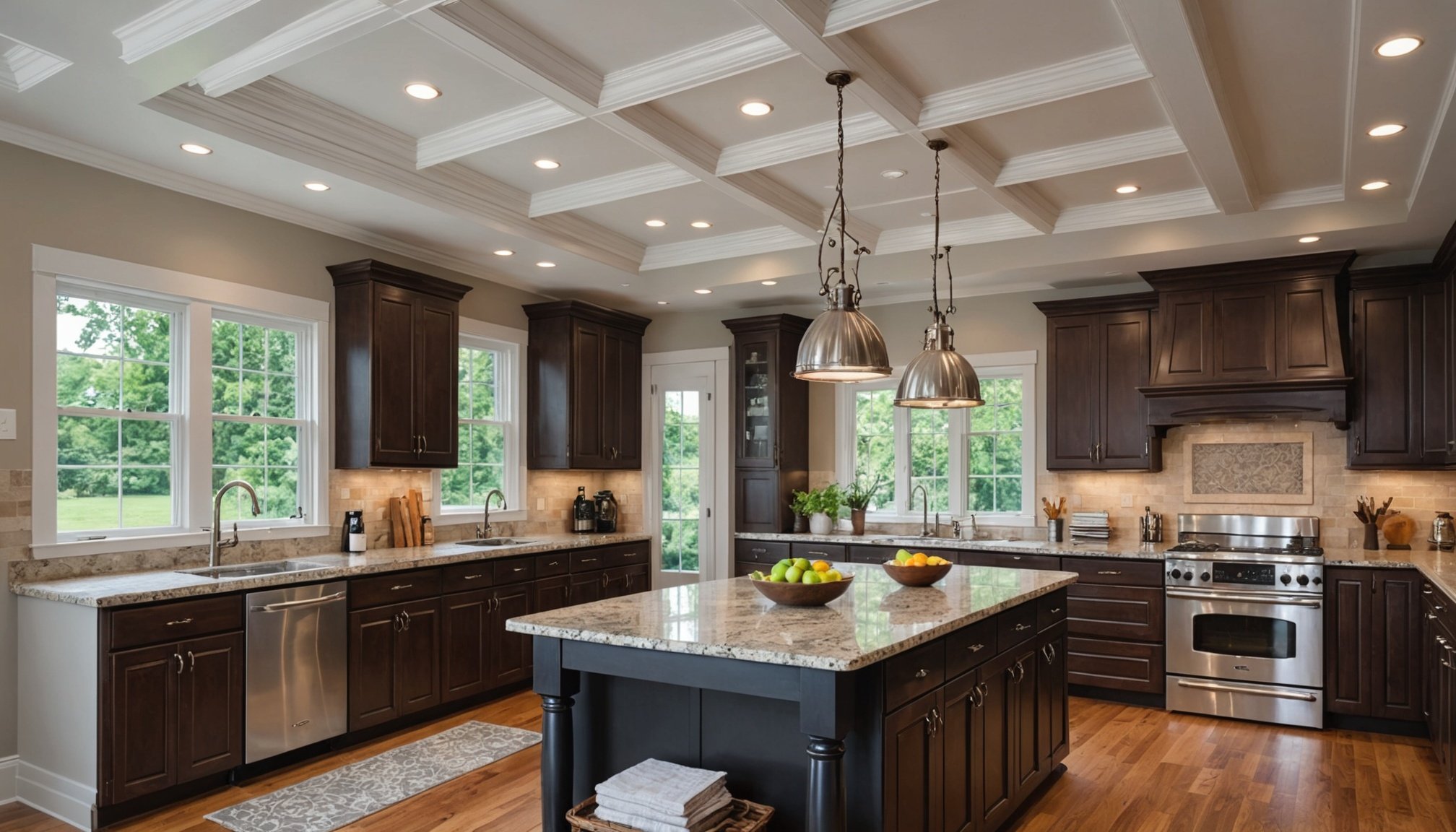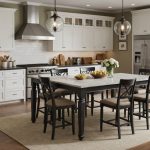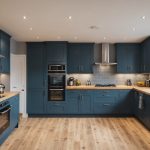Top Kitchen Ceiling Materials for Enhanced Cleanliness and Health: A Comprehensive Guide
When it comes to designing or renovating a kitchen, whether it's for a residential or commercial space, the ceiling is often an overlooked but crucial aspect. The right ceiling material can significantly impact the cleanliness, health, and overall aesthetic of your kitchen. Here’s a detailed guide to help you choose the best ceiling materials for your kitchen, ensuring a clean, healthy, and visually appealing space.
Understanding the Importance of Clean Ceilings in Kitchens
Kitchens, especially commercial kitchens, are prone to moisture, grease, and food particles, which can lead to the formation of mold, mildew, and other health hazards. A clean ceiling is not just about aesthetics; it's essential for maintaining a hygienic environment.
Also to discover : Unlock Healthier Eating: The Impact of Clear Fridge Doors on Dietary Choices in Your Home
"Clean ceilings are critical in kitchens because they prevent the accumulation of dust, moisture, and other contaminants that can fall onto food and cooking surfaces," notes a kitchen design expert. "This is particularly important in commercial kitchens where food safety regulations are stringent."
Key Characteristics of Ideal Kitchen Ceiling Materials
When selecting ceiling materials for your kitchen, several key characteristics should be considered:
Also read : Unlocking the Power of a Kitchen Chalkboard: How It Can Transform Your Diet Tracking Journey
Moisture Resistance
Moisture is a significant concern in kitchens. Materials that are water-resistant or waterproof are ideal to prevent dampness and mold growth.
Ease of Cleaning
Materials that are easy to clean and maintain are essential. This includes surfaces that can be washed with mild soap and water or even power-washed if necessary.
Durability
The material should be durable and able to withstand the kitchen environment, including exposure to heat, grease, and cleaning chemicals.
Fire Resistance
Fire safety is paramount in kitchens. Materials with a Class A fire rating are highly recommended.
Aesthetic Appeal
The material should also fit with your interior design goals, providing a clean and modern look.
Top Ceiling Materials for Kitchens
Here are some of the top ceiling materials that meet these criteria, each with its unique benefits and applications.
PVC Ceiling Tiles
PVC (Polyvinyl Chloride) ceiling tiles are a popular choice for kitchens due to their numerous benefits.
- Moisture Resistance: PVC tiles are completely waterproof and resistant to moisture, making them ideal for areas prone to dampness.
- Ease of Cleaning: These tiles are easy to clean with mild soap and water or household cleaners. They can even be power-washed if needed.
- Durability: PVC tiles are highly durable and can withstand the harsh kitchen environment. They are also resistant to chemicals and unaffected by moisture.
- Fire Resistance: Many PVC tiles have a Class A fire rating, ensuring they meet stringent fire safety standards.
Example:
Duramax PVC Wall and Ceiling Panels are made from 100% virgin PVC and are highly resistant to chemicals and moisture. They are FDA-approved and meet USDA and CFIA requirements, making them perfect for commercial kitchens and food prep areas.
Vinyl Ceiling Tiles
Vinyl ceiling tiles are another excellent option for kitchens, offering similar benefits to PVC tiles.
- Moisture Resistance: Vinyl tiles are waterproof and resistant to mold and mildew, making them suitable for kitchens.
- Ease of Cleaning: These tiles are easy to clean and maintain, with the ability to be washed with mild soap and water.
- Durability: Vinyl tiles are durable and can withstand the kitchen environment. They are also UV-stabilized to prevent degradation over time.
- Fire Resistance: Vinyl tiles often have a Class A fire rating, ensuring they are safe for use in kitchens.
Example:
DuraClean Smooth White 2×2 Ceiling Tiles by uDecor are made from UV-stabilized pure PVC vinyl. They are waterproof, mold/mildew resistant, and have a Class A fire rating. These tiles are perfect for industrial and commercial areas, including food processing plants and food prep areas.
Acoustic Ceiling Panels
While not as commonly used in kitchens, acoustic ceiling panels can still be a viable option, especially in larger commercial kitchens where noise reduction is necessary.
- Moisture Resistance: Some acoustic panels, like those from USG, have antimicrobial additives and are designed to resist moisture and mold growth.
- Ease of Cleaning: These panels are generally easy to clean, although they may not be as resistant to heavy cleaning as PVC or vinyl tiles.
- Durability: Acoustic panels are durable but may not be as robust as PVC or vinyl tiles in a kitchen environment.
- Fire Resistance: Many acoustic panels meet fire safety codes and have low VOC emissions.
Example:
USG Clean Room Acoustical Panels with ClimaPlus Performance are designed for clean rooms and can be used in kitchens. They have an embossed, vinyl-laminated face and sealed back and edges, making them resistant to moisture and mold.
Comparison of Top Ceiling Materials
Here is a detailed comparison of the top ceiling materials for kitchens:
| Material | Moisture Resistance | Ease of Cleaning | Durability | Fire Resistance | Aesthetic Appeal |
|---|---|---|---|---|---|
| PVC Tiles | High | Easy | High | Class A | Modern, Clean |
| Vinyl Tiles | High | Easy | High | Class A | Modern, Clean |
| Acoustic Panels | Medium | Moderate | Medium | Meets Fire Codes | Neutral |
Practical Tips for Installing and Maintaining Kitchen Ceilings
Installation Tips
- Measure Carefully: Ensure you measure your ceiling grid accurately to avoid any fitting issues.
- Use the Right Tools: For PVC and vinyl tiles, use a utility knife or a skill saw for cutting. For acoustic panels, follow the manufacturer's installation guidelines.
- Consider Samples: Before installing, use samples to ensure the tiles fit well in your ceiling grid and do not have a bowed appearance.
Maintenance Tips
- Regular Cleaning: Clean your ceiling tiles regularly with mild soap and water. For tougher stains, power-washing can be an option, but avoid using abrasive cleansers or acidic chemicals.
- Inspect Frequently: Regularly inspect your ceiling for any signs of damage, mold, or mildew. Address any issues promptly to maintain a clean and healthy environment.
- Use Baking Soda: For stubborn stains or odors, a baking soda and water paste can be effective. Apply the paste, let it sit, and then wipe clean with a damp cloth.
Real-World Applications and Success Stories
Commercial Kitchens
Commercial kitchens benefit significantly from the use of PVC and vinyl ceiling tiles. For instance, a cloud kitchen setup using Duramax PVC panels can ensure a clean and hygienic environment without the need for extensive maintenance. These panels meet FDA and USDA requirements, making them ideal for food prep areas.
Residential Kitchens
In residential kitchens, vinyl ceiling tiles like DuraClean can enhance the interior design while providing a practical solution for cleanliness. A homeowner who installed DuraClean tiles in their kitchen noted, "The tiles are not only easy to clean but also look modern and sleek, completely transforming the look of our kitchen."
Choosing the right ceiling material for your kitchen is a critical decision that impacts cleanliness, health, and aesthetic appeal. PVC and vinyl ceiling tiles stand out as top choices due to their moisture resistance, ease of cleaning, durability, and fire resistance. By understanding the key characteristics of these materials and following practical installation and maintenance tips, you can ensure your kitchen ceiling remains clean, healthy, and visually appealing for years to come.
In the words of a kitchen designer, "A well-chosen ceiling material can make all the difference in maintaining a clean and healthy kitchen environment. It's not just about aesthetics; it's about ensuring the space is safe and functional." By making an informed decision, you can create a kitchen that is not only beautiful but also safe and hygienic.











